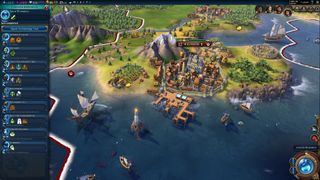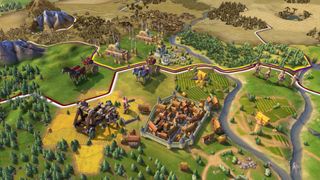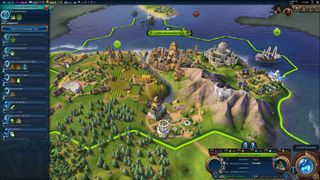
Given the choice, how would you take over the world? Sid Meier’s Civilization VI, available now, lets you answer that very question in the most in-depth and complete way ever seen in the series.
Taking the traditional Civlization formula and building on it in unique new ways, the sixth game in the main series brings back the elements you know and love - leaders, conquest, scientific discovery, building an empire - and combines them with brand new features. From the districts that surround your cities, through the much improved tutorial systems and brand new leaders with their powers and units - all of it comes together in the deepest, most accessible Civilization game to date.
Leaders have always been a key to the lure of Civilization, and the sixth game in the main series brings with it a huge range of new leaders – and civilizations, naturally – to choose from.
Civilization VI offers new ways to interact with your world, expand your empire across the map, advance your culture and compete against history’s greatest leaders to build a civilization that will truly stand the test of time.

One of the biggest changes to Civilization VI comes in the form of ‘districts’ – while previous games in the series allowed you to build a city and have everything included on the tile it was created, districts mean players have more control than ever before over how their empire grows… or how it might fail.
It might seem like the game’s complexity has been upped as a result, but a lot of work has been put into the amount of information offered on-screen to the player and making relevant information more visual, meaning you’ll never be lost as to what’s going on. Backing this up is a robust and deep tutorial system, able to ease newcomers – or those who need to polish up their skills – into the experience.
From a visual perspective, the new districts mean your cities will physically grow across the world map. It’s a simple change, but one that makes it all the more rewarding when you conquer half of the known world (as well as more visually obvious that you have conquered it).
PC Gamer Newsletter
Sign up to get the best content of the week, and great gaming deals, as picked by the editors.
It’s not just visual, of course, with strategy involved in picking not just where your initial city lives, but where it is able to expand to. Choose an area without space for your people to spread into, and you’ll be lost before you even get going. Pay attention to your surroundings, though, and you’re golden.

For example, using the English civilization, players would want to take advantage of the unique district – the Royal Navy Dockyard. This, of course, has to be built on water - meaning you will be playing with proximity to the sea in mind from the very beginning. Otherwise you won’t be able to use the English’s unique unit, the Sea Dog. It’s a very natural evolution of the way you think about common Civilization themes.
Whichever leader you choose for your empire – be it Russia’s Peter the Great, Arabia’s Saladin, Rome’s Trajan, or any of the other historical figures represented in Civilization VI, you’re sure to have a different experience.
Each, as is traditional for Civilization, has different abilities, units and agendas enabling their conquest of the world. Or maybe their cultural expansion. Or diplomatic journey. This being Civilization, it doesn’t have to just be war and battle that brings victory – science, diplomacy, culture; all can be used to win over the populaces of other nations and states.
Say, for example, you choose to lead the Roman Empire as the aforementioned Trajan: you will be able to take advantage of the unique unit, the Legion and build unique districts of Roman Baths all while taking advantage of Trajan’s populist policies. A happy people is a productive people, after all.
Maybe you want to take things in a more combative direction – Spain and its leader Philip II might be more to your taste. With a proclivity for holy war (and the Spanish Inquisition, no less), Philip II enables players in Civilization VI to build Missions – able to convert the nonbelievers – and train up Conquistadors, skilled at exploration, colonisation and spreading your religion.
Whichever way you choose to play Civilization VI, you’re always able to change things up if – and when – you want to. No two playthroughs are the same: an ever-changing map will create different active research paths, for example, mean there are ever-changing discoveries to be made, allowing you to explore, develop your environment and discover new cultures in entirely different ways.

Diplomacy with other cultures is another area that always changes – your rival (or friendly) leaders all have their own motivations and desires, and it’s up to you how you deal with them. If you even deal with them at all – ignorance is, after all, a valid tactic. Though admittedly negotiation and alliance is probably a better tactic.
All in all, Civilization VI – which is out now – has something for all levels of player. The experts have probably all picked the game up already, of course, and are learning about all the new features and approaches they’ve never been privy to before. But for the newcomers there’s a whole world of exploration, expansion, exploitation and extermination to be done.
It’s easier than it’s ever been to get into Civilization, thanks to the previously mentioned tutorial system and the more readable map, while the breadth of leaders available means there’s always a play-style supported, regardless of how you want to approach things.
It’s the biggest, best, deepest and most accessible game in the series yet – check out Civilization VI today.
